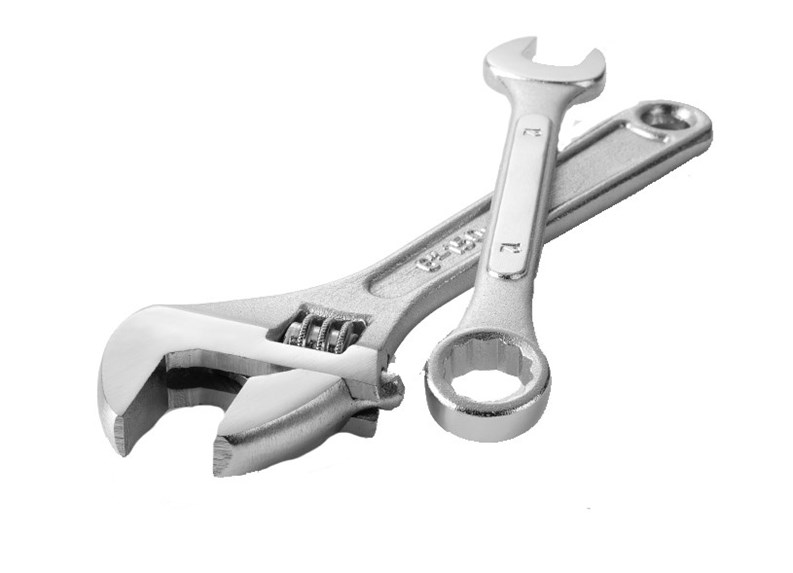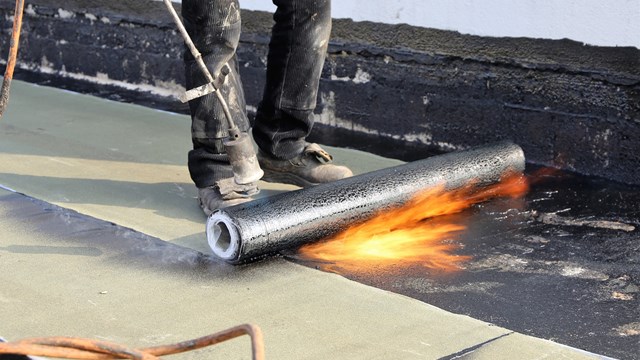While it may be a cliché, it's entirely true that few things are more important than keeping a solid roof over your head. And like any other aspect of a building's structural composition, your roof has a life span that is dictated by time, wear-and-tear, and environmental conditions.
On average, a roof that is properly maintained lasts longer and is less vulnerable to leaks. If damage from the sun, wind, snow and rain are left unchecked, the result will be leaks and serious damage to other parts of the building, like the façade, the stairwells and the windows. While leaks normally start slow, they can create ideal conditions for rot, mold, and fungus to grow in attics and wall framings, which is not only costly to eradicate, but can also pose a dire heath hazard for residents. Given the high stakes, it's important to know what type of roof is over your head, its current condition, and the terms of its warranty.
For most buildings, and depending on which system is used, a roofing manufacturer will normally give a 20-year warranty, although some will give 10-, 15- or 25-year terms. Regardless of the length of the warranty, the reason for the respective period of time, explains Abe Grossman, regional sales manager for the Bayonne, New Jersey-based Garden State Services, LLC, which serves the tri-state area, "is that most roofs are built to last for longer than the warranty stipulates. "If they give a 20-year warranty, that means it will probably last for 30 [years] because these roofs are tested, and no manufacture is going to stick their necks out," says Grossman. Some companies like CertainTeed, for example, have several roofing products for which they offer 50-year or lifetime warranties, but it depends on the product and the type of roofing material being installed.
While some industry experts recommend hiring a specialty inspector or reputable roofer to examine a roof every year or two, this job should really be done twice a year, usually in the spring and fall - after the ice thaws and again before the snow starts. Ice causes building materials to expand and contract, which can weaken seals and lead to leaks. Heavy snow, on the other hand, adds weight, which may also cause problems if roof surfaces warp and buckle under the load. Both scenarios are hard to avoid, and can seriously compromise a roof's integrity.
The best way to preserve a roof is to conduct biannual inspections to check for damage and take preventive steps before bedrooms turn into pool rooms. "When it comes to roofs and leaks, you have to be a detective, like Colombo, and keep asking questions," Grossman says.
"Two qualified roofers walking around up there for a day and inspecting with the proper equipment buys you time," says Gary Zaremba, president of the New York City-based Artisan Restoration Group. He adds that on average, a flat roof inspection should cost between $700 and $1,000.
Grossman agrees, and adds that all too often, building owners don't follow regular inspections schedules and only deal with the roof when an emergency is reported, which is often too late. "A roof should be inspected two times a year to make sure the membrane hasn't lifted, or that coping tones and flashing aren't loose," he continues. "[Buildings] usually don't do [inspections], but they should. It can save thousands of dollars and adds years to the roof."
Inspections can turn up big problems - or head them off at the pass - but they can also highlight smaller repairs your building supervisor or managing agent may be able to handle relatively simple repairs like caulking, cleaning out gutters and removing standing water that need not necessitate a visit from your roofing contractor. "Simple maintenance goes a long way," says Zaremba.
Roof Membranes
Before discussing actual repair methods, it's important to understand that there are a number of different component parts of a roof membrane, most of which can be researched by either reading the roof's original warranty or by discussing the issue with the company that installed it. Often, a roofer is kept on retainer after the roof is installed.
The most common roofs are asphalt, shake, slate/tile and tar and gravel, but, "it all depends on what roof was installed," says Craig Alper of the Long Island City-based Allied Contracting Corporation. "There can be as many as four or five layers to a roof."
For example, shake roofs have a layer of treated felt or tarpaper under each row of wooden shingles to serve as a waterproofing barrier. The shake surface is worn away by the sun and weather, however, and holes eventually develop, exposing the underlying felt to the sun. Damaged shakes can be repaired by inserting a thin wood shingle, a piece of composite mineral shingle, or a piece of sheet metal under the area in question.
With slate or tile roofing, the general rule of thumb has traditionally been to replace any broken slates or tiles to avoid further problems, although there are special adhesives available that can effectively repair broken tiles.
Tar and gravel roofs, also know as built-up roofs - and the most common type of roofing system in New York City - require regular maintenance too. The perimeters of these lower sloped roofs are often left uncovered and are exposed to damages from the sun. In areas where the asphalt is exposed, there should be a coating of an aluminized asphalt emulsion or one of the new rubberized white roof coatings.
While it's assumed that with pollution, snow build-up, and more traffic in multi-family buildings, urban roofs might be more at risk than suburban or rural roofs, the major contributing factor to wear on any roof is weather. "The factors of urban or suburban doesn't have great play in this situation," says Grossman. "It's the climate."
"In the city we have a freeze-and-thaw cycle, which creates movement and cracks," says Zaremba, adding that extreme winters often will result in serious cracks come spring. In addition, piled-up snow should be removed from flat roofs by building staff. It's also important to make sure that areas on the roof that have collected "ponds" of standing water be marked because that is where most leak problems start.
In addition to weather, city buildings do have a few other considerations to contend with, like vandalism and people using roofs not built for social reasons in the summer months, both of which can contribute to troubled areas, says Alper.
For most building owners and property managers, the common response to any roof problems is patching, which can temporarily stop leaks and increase the longevity of the roof - but this can only postpone the inevitable.
"It's not cost-effective in the long run to keeping patching leaks," says Alper. "You have to look at it like an old car and say to yourself "˜Do I want to keep putting money into this old car?'"
In most cases, the existing roof can be built upon, which is the most cost-effective route. However, in cases where the roof has to be completely removed or rebuilt, clearly the costs will increase exponentially. Some factors that determine the final cost of the project are location and accessibility to the roof, including the contractor's ability to get supplies and workers to the location.
Cost per square foot for a new roof system ranges between $4 and $35 - which is a considerable discrepancy - but industry professionals say that since each roof is completely different an honest assessment of repair or replacement costs can't be quantified unless there is an inspection. "There are too many elements to consider," says Grossman. "The flashing could be shot for example, or it could be something else; it's just too hard to tell without looking at it."
Zaremba recommends cutting a section of the roof's membrane to test for moisture and hazardous materials in order to get a sound professional opinion on whether the roof needs to be reconditioned or completely removed and rebuilt. "If the existing roof can be built upon, you may still be able to get a warranty on the new roof, but if the roof is completely gone, the roof has to be removed, which increases the costs considerably," says Zaremba.
Another consideration is if the roof contains toxic materials like asbestos, which requires a specialized work force, and proper permits. "Removing roofs with asbestos can run an additional four to eight dollars per square foot," says Zaremba.
Depending on the location of the roof and how long it takes to get materials on and off of it, Alper says that an experienced crew of workers should be able to complete 3,000 to 4,000 square feet per day.
Since roof repairs are inevitable, it's vital that a building's board or management keeps the reserve fund robust for repair, replacement, and maintenance. This figure should be calculated in relation to the cost of the original roof and the number of years left on the warranty, and should also include monies for biannual inspections.
"You have to put money aside for maintenance because one day you'll have to face the music," says Grossman. However, he adds that most building owners are more concerned with other maintenance expenses - and more often than not, the roof is overlooked. "The roof doesn't add that much value and it's usually the last thing a [board] does," he adds.
There have been new roofing technologies developed over the last 20 years, such as "green roofs," which are roofs that are been covered with a dense mat of low-growing succulent and alpine plants that grow from a waterproof membrane that is installed on the roof. While this technology is somewhat new, it's thought that the insulation benefits will eventually balance out initial costs, which can range between $15 an $20 per square foot to install.
Another option is a sprayed polyurethane foam (or SPF) that adheres to just about everything and can be installed over concrete, wood, steel, and most existing roof systems, and saves on the expense of roof removal and landfill fees. It is very durable but does need a protective elastomeric coating installed over it because it's very susceptible to UV rays and "Mechanical Damage" mechanical damage. The cost ranges between $2 and $4 per square foot but can last up to 50 years if installed properly. Since the foam acts as insulator, it can cut down on heating and air conditioning bills, which makes it a cost effective option.
While these new initiatives are beginning to show positive results, industry professionals adhere to standard applications. "A lot of this is hype," says Alper of newer roofs. "In my opinion the old tar roofs are still the best and that is what we are seeing 95 percent of the time."
While Grossman feels that these new technologies could be advantageous in the future, he said there isn't enough research and statistics to say these roofs will outlast or perform better than the roofing materials that have been traditionally used, especially in the northeast. "People are always looking for the next best roof, but these new roofs haven't been on the market long enough to be amortized. We have four seasons and dramatic climate changes and that has to be taken into consideration," says Grossman.







Leave a Comment